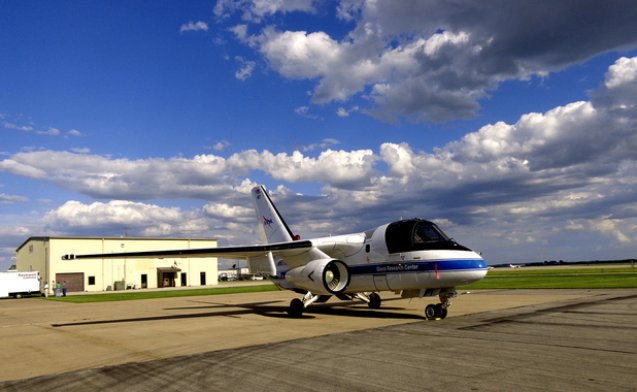 NASA and Rockwell Collins have completed the first phase of flight-testing on a new public-use airborne data link designed to safely and securely connect ground-based pilots to all types of civil unmanned aircraft in the U.S. national airspace system.
NASA and Rockwell Collins have completed the first phase of flight-testing on a new public-use airborne data link designed to safely and securely connect ground-based pilots to all types of civil unmanned aircraft in the U.S. national airspace system.
The research, development and testing is part of a broader portfolio of unmanned aircraft system (UAS) work underway at NASA, including sense- and-avoid technologies.
“The data link is the lifeline that connects the pilot to the aircraft,” says John Moore, principal investigator for the NASA-Rockwell Collins unmanned aircraft control and non-payload communication project. Under the cost-sharing arrangement, Rockwell Collins is providing the prototype radios as well as engineering support to develop the waveforms, which NASA says will be non-proprietary and released “as a public resource” when completed.
Along with engineering and flight-test support, NASA is providing its Lockheed S-3 Viking for the flight tests. Results of the testing will be used by a new RTCA committee (Special Committee 228) to develop minimum standards for the equipment, in advance of FAA actions meant to comply with a congressional mandate to integrate unmanned aircraft into U.S. airspace by 2015.
NASA’s vision for the control link is similar to the cell phone network, where multiple users are connected to a single ground station and transition seamlessly to adjacent ground stations as they travel into a adjacent service areas. Today, unmanned systems typically use a one-to-one control link with a unique frequency between the aircraft and the pilot in the ground station, a model that will be problematic as the expected number of domestic UAS operations ramp up. “There are not enough frequencies to go around,” says Moore.
A key challenge for NASA and Rockwell Collins is handling a large amount of traffic with very little spectrum. The World Radiocommunication Conference in February 2012 assigned two “chunks” of ground-based spectrum for UAS users worldwide, one in the L- band and one in the C-band, explains Jim Griner, NASA’s communications project engineer on the program. “Our project is to build prototype equipment to verify the art of the possible in that spectrum.”
The narrowband allotments will translate to only a few hundred frequencies that will be used across the U.S., and allow for a 7-kbps uplink rate and 14-300-kpbs downlink rate, says Griner. Re-use of frequencies requires enough distance so the curvature of the Earth isolates users on the same frequency.
Moore says the basic building blocks of the waveform in the prototype are “very familiar,” but the way the elements of the radio are put together is unique. “We are optimizing the system to put more hardware on the ground so the aircraft unit is smaller, enabling it to work on aircraft weighing less than 100 lb.,” he says.
NASA began flight-testing the first “spiral” prototype radio from Rockwell Collins in late May on the NASA S-3 at the Glenn Research Center in Cleveland, accumulating 20 hr. of operating time on the first-generation radio communicating with a single ground station. The spiral one radio operates in the L-band only, but a follow-on test in Iowa on June 18 provided 4.5 hr. of flight time as a risk-reduction measure for the added C-band capability for the “second spiral” radio, due to be completed in September, with flight tests finished in March 2014.
The second spiral testing will include handoffs between two ground stations using the S-3. The third and final spiral radio is slated to be completed in 2015, followed by flight-testing that will include data-link security, multiple ground stations and multiple aircraft, using a UAV surrogate controlled by a pilot on the ground but also with a safety pilot on board.
During the first spiral flight tests, Griner says the S-3 flew at several different speeds and altitudes up to 10,000 ft., measuring the waveform at the edge of coverage area and how it degrades as the signal strength is reduced.
Moore says the use of L-band versus C-band will be a “big part” of the work in front of the RTCA committee, but one option might be using both spectrums simultaneously for a hot backup, in case one fails.
Noting the critical importance of the data link, Moore adds “The bar will be higher” for the safety and security attributes that will be required of the final product.
Source: Aviation Week
